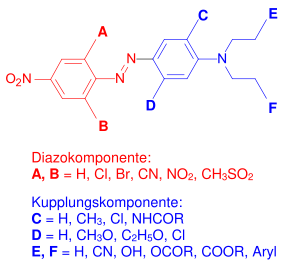Disperse dyes
The disperse dyes are a class of dyes for dyeing hydrophobic fibers and fabrics , for example polyester . The dyes are distinguished by their very low solubility in water. They are ground very finely together with dispersants , so that the molecularly dissolved dye components can diffuse into the fiber during the dyeing process and form a solid solution there. Most disperse dyes belong to the azo dyes .
Chemical properties
About 60% of the disperse dyes are azo dyes and about 25% belong to the group of anthraquinone dyes , with which brilliant red, blue or turquoise tones can be achieved. In addition, other chromophores are used, with which essentially yellow tones are produced.
Among the disperse dyes from the group of azo dyes, the monoazo dyes dominate. The most important diazo components are 4-nitroaniline and its derivatives . Typical coupling components are N -alkylated derivatives of aniline , m -toluidine , m -chloroaniline and 3-aminoacetanilide.
In particular, by varying the substituents E and F , the requirements of the different types of fiber can be adjusted. For example, hydroxyalkyl groups (E, F = OH) are suitable for many acetate fiber dyes; If the hydroxyl group is replaced by a less hydrophilic cyano or ester group , the affinity for polyester fibers is increased. Some disperse dyes are made with heterocyclic diazo components, for example aminothiazole or aminobenzothiazole derivatives .
Post-treatment after chemical synthesis plays a major role in the production of disperse dyes . The dyes must be present as a stable, fine dispersion during the dyeing process. This is achieved by a thermal aftertreatment in the presence of nonionic detergents and by a grinding process, whereby particle sizes <1 µm with a narrow particle size distribution are aimed for.
Examples
history
The first disperse dyes for dyeing acetate fibers were introduced in 1923 by British Celanese and the British Dyestuffs Corporation . From 1950, the production volume of disperse dyes increased by leaps and bounds, parallel to the global production of synthetic fibers. There were developed new dye, for example, the very high demands of the automotive industry to the light fastness or new fastness properties contributed, such as the thermo-migration fastness, Bill.
Individual evidence
- ↑ Entry on disperse dyes. In: Römpp Online . Georg Thieme Verlag, accessed on January 23, 2019.
- ^ A b c Klaus Hunger (Ed.): Industrial Dyes: Chemistry, Properties, Applications . WILEY-VCH Verlag, Weinheim 2003, ISBN 978-3-662-01950-4 , p. 134 ff . ( limited preview in Google Book search).
- ↑ External identifiers or database links to Disperse Yellow 3 : CAS number: 2832-40-8, EC number: 220-600-8, ECHA InfoCard: 100.018.728 , GESTIS substance database : 113516 , PubChem : 17811 , ChemSpider : 10468668 , Wikidata : Q27032530 .
- ↑ External identifiers or database links to Disperse Orange 44 : CAS number: 4058-30-4, EC number: 223-765-4, ECHA InfoCard: 100.021.606 , PubChem : 77677 , Wikidata : Q72469756 .
- ↑ External identifiers or database links for Disperse Blue 79 : CAS number: 3618-72-2, EC number: 222-813-1, ECHA InfoCard: 100.020.740 , PubChem : 77172 , ChemSpider : 69605 , Wikidata : Q27268781 .
- ↑ External identifiers or database links to Disperse Red 177 : CAS number: 68133-69-7, EC number: 268-697-6, ECHA InfoCard: 100.062.433 , PubChem : 109546 , ChemSpider : 98482 , Wikidata : Q72469815 .
- ↑ External identifiers or database links to Disperse Blue 87 : CAS number: 12222-85-4, EC number: 602-270-0, ECHA InfoCard: 100.112.834 , PubChem : 319120669 , ChemSpider : 75277 , Wikidata : Q90008613 .
- ↑ External identifiers or database links for Disperse Orange 11 : CAS number: 82-28-0, EC number: 201-408-3, ECHA InfoCard: 100.001.281 , PubChem : 6702 , ChemSpider : 6447 , Wikidata : Q27155911 .







